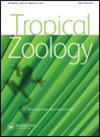巴西穴居电鱼特征鱼的生物学和行为(Teleostei:裸子形目:胸骨鱼科):与上古物种trilineata的比较,以及洞穴生活的后果
IF 0.7
4区 生物学
Q4 ZOOLOGY
引用次数: 6
摘要
我们比较了来自巴西中部圣多明戈斯喀斯特地区的三球地黄及其表观亲缘三线虫的行为,包括空间分布、对刺激的反应、活动阶段、激动性相互作用以及饮食和繁殖。我们利用了随意的水下观测,辅以物理化学水变量、栖息地描述和标本收集。行为方面的差异包括副戊烯虫没有隐生物习性,空间和时间活动延长,而这在三线虫中是不存在的,觅食角度在副戊烯属中约为30°,在三线藻中约为90°。记录到的三球虫E.vicentespelaea的痛苦行为可能与其表观亲属的性格状态的保持有关。与其他本氏电鱼类似,本氏副鳍电鱼和三线鳗可能被认为是底栖性倒食性鱼类,没有证据表明它们胃中猎物的数量和多样性具有季节性,这表明这两个物种有共同的食物谱。来自Goiás的表观和三球特征鱼都在旱季繁殖,没有迹象表明这一时期的繁殖高峰。本文章由计算机程序翻译,如有差异,请以英文原文为准。
Biology and behavior of Eigenmannia vicentespelaea, a troglobitic electric fish from Brazil (Teleostei: Gymnotiformes: Sternopygidae): a comparison to the epigean species, E. trilineata, and the consequences of cave life
We compared the behavior, including spatial distribution, reaction to stimuli, activity phases, and agonistic interactions, as well as diet and reproduction, of the troglobitic Eigenmannia vicentespelaea and that of its epigean relative, E. trilineata, both from São Domingos karst area, central Brazil. We utilized ad libitum underwater observations, complemented by physicochemical water variables, habitat descriptions, and collections of specimens. Differences in behavioral aspects include the absence of cryptobiotic habits and an extended spatial and temporal activity in E. vicentespelaea that were not present in E. trilineata, and the foraging angle, which was approximately 30° in E. vicentespelaea and 90° in E. trilineata. The agonistic behaviors recorded for the troglobitic E. vicentespelaea could be related to the preservation of a character state that is present in its epigean relatives. Eigenmannia vicentespelaea and E. trilineata might be considered benthophagous invertivores, similar to other Eigenmannia electric fishes, with no evidence of seasonality in the volume and diversity of prey items in their stomachs, suggesting that there is a food spectrum common to the two species. Both epigean and troglobitic Eigenmannia fish from Goiás reproduce during the dry season, with no indication of reproductive peaks during this period.
求助全文
通过发布文献求助,成功后即可免费获取论文全文。
去求助
来源期刊

Tropical Zoology
生物-动物学
CiteScore
2.50
自引率
0.00%
发文量
1
审稿时长
>12 weeks
期刊介绍:
Tropical Zoology is an international zoological journal publishing original papers in the field of systematics, biogeography, phylogeny, ecology and conservation of all terrestrial and aquatic animal Phyla from tropical and subtropical areas.
Only papers with new information, high quality and broad interest are considered. Single species description and checklists are not normally accepted. Review papers are welcome. The journal is owned by the Istituto di Ricerca sugli Ecosistemi Terrestri of the Consiglio Nazionale delle Ricerche, Florence, Italy (CNR-IRET) who performs research into the structure and functioning of aquatic and terrestrial ecosystems, focusing in particular on anthropogenic pressure and global change. The knowledge amassed forms the scientific basis for identifying the most appropriate protective and corrective interventions, and provides support for the bodies entrusted with formulating policies for environmental protection and recovery.
 求助内容:
求助内容: 应助结果提醒方式:
应助结果提醒方式:


